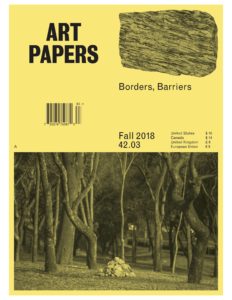Borders / Barriers
Share:
Continuing with our yearlong “Art of the Built Environment” explorations,  this issue of ART PAPERS looks to Borders and Barriers. Borders serve the hegemonic imperative to etch a line between an us and a them. Barriers enforce/reinforce the divide between insider and outsider. As such, borders, and the constructed barriers that inscribe them, serve to mediate difference toward legibility. They often get drawn where difference is most contested—girded when the ruling order is threatened, militarized when a threat grows stronger. Borders possess a logic that is reproduced at multiple scales and through multiple applications—whether the fence that divides neighbors, the walls that demarcate contested or occupied nation-state divides, or the politicization of the spaces between us.
this issue of ART PAPERS looks to Borders and Barriers. Borders serve the hegemonic imperative to etch a line between an us and a them. Barriers enforce/reinforce the divide between insider and outsider. As such, borders, and the constructed barriers that inscribe them, serve to mediate difference toward legibility. They often get drawn where difference is most contested—girded when the ruling order is threatened, militarized when a threat grows stronger. Borders possess a logic that is reproduced at multiple scales and through multiple applications—whether the fence that divides neighbors, the walls that demarcate contested or occupied nation-state divides, or the politicization of the spaces between us.
We find ourselves in a moment of fierce focus upon borders and their structures. Almost daily in the United States, our attention is directed toward calls to wall-off, reinforce, or even close the border between Mexico and the US, and we see the escalation of atrocious treatment imposed on people who attempt to cross northward in search of asylum and opportunity. So, borders and barriers are not just sites, they are events that can be experienced. They have the power to deny, accept, and/or transform. They are spaces of division, yet they also can be spaces of mixing or blurring varied perspectives, and of shared cultures and histories. Curator Humberto Moro weaves together some instances of border-addressing performance art from the Mexico side, connecting our past, present, and future through Imaginary Lines.
People who cross a border, or break through a barrier, often feel that they carry the other side within them—as one lived reality nested inside another. Selected poems by Sudanese-American author Safia Elhillo capture the poignant complexities of this condition, as does Orit Gat’s look at ways of seeing the Separation Wall between Israel and Palestine for our recurring Glossary feature. Omar Kholeif revisits Beirut, offering a dreamy personal narrative through which to consider the value of return.
This issue seeks to create productive connections between various border contexts, and to tease out ways artists resist or are complicit in the reconfiguration of space. Inside US cities, the influx of affluent homebuyers to city centers has produced a new white flight, this time displacing the working-class and middle-class families, often of color, who have held neighborhoods intact despite often-insufficient resource support from the cities they’ve kept vibrant. These realities, although resurgent in the cultural discourse of North America, are far from isolated or unique.
Chris Fite-Wassilak breaks down the role of public artworks and high-design concept artist communities in the expansion of London’s city center, whereas TK Smith tells a material history of St. Louis brick and the artists who have harnessed its material poetry. In Los Angeles a group of Armenian-American artists sat down with Sara Wintz to discuss the whitewashing of diasporic artists’ contributions in their own historic neighborhoods—and how to fight back. Artist Aaron Gemmill has spent years photographing the proliferation of luxury condominiums, mostly in Brooklyn, NY. His project for this issue is a selection of these photos (which Gemmill originally posted to Instagram under the hashtag “#condoreport”) and his prints of the Plexiglas windowpanes used to give passersby a glimpse inside construction sites. The pairing presents a meditation not only upon the rise of luxury housing but also upon who is inside and who is outside looking in.
Borders are enticing for symbolic engagement; after all, they are actual manifestations of a symbolic binary. Reema Salha Fadda writes about the appropriation of Palestinian symbolic space as a tool of violence and draws connections to other such apparitional dispossessions. Artist Kahlil Irving’s centerfold project addresses the use of language and image in media depictions of racialized violence to reinforce white supremacist beliefs. The collage work draws connections between the delineation of space and reinforced difference.
Also in this issue, guest designer Benjamin Critton gestures toward building up and breaking down borders and barriers—drawing inspiration from featured articles, as well as from ART PAPERS’ archives. We hope this small contribution to an immense and complex topic will prove inspiring, and perhaps instigate new ways of thinking about the logic of Borders.
Sarah Higgins
Interim Editor
editor@artpapers.org